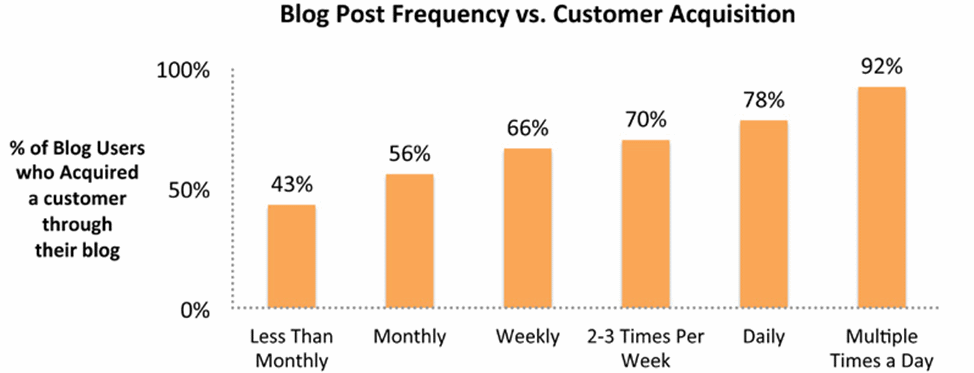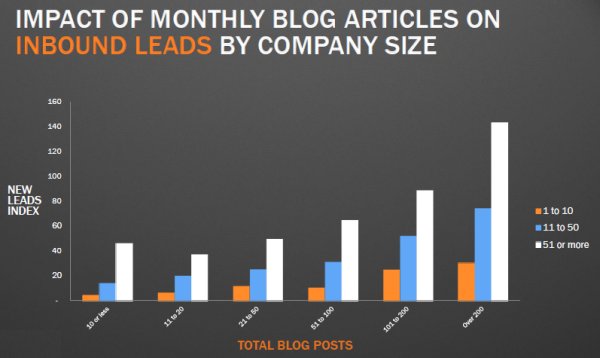How Often Should You Update Your Blog?

Deep down, we all know the general answer to this question. You should blog as much as possible, until your quality starts to slip. The point where your length, depth and originality start to slip is the point where you should scale it back.
When it comes to blogging, is more always better?
Some of us are familiar with HubSpot’s state of inbound report, which has consistently found that the more blogs you publish, the more traffic, leads, and sales your business will generate.

Many of us have also noticed that big-name blogs, from HubSpot to Jeff Bullas blog at least once daily. In fact, it’s pretty rare to encounter a notable business blog that doesn’t blog at least five times a week.
But what do the case studies say? And more importantly, is there a right answer across industries and business sizes? That’s exactly what we set out to explore in this blog.
What the Research Found
Without a doubt, the best-known study on blogging frequency is HubSpot’s, which is illustrated below:

It’s clear that with few exceptions, the more you blog, the better your results will be. When it comes to lead generation, the companies who were able to blog 3-4 times daily saw by far the best results. This data is drawn from thousands of organizations, which run the gamut from tiny enterprises to major corporations, so it’s safe to say that it’s one of the most comprehensive studies to date.
But what about other data on how often to update your blog?
Unfortunately, there really isn’t much to draw from. Aside from anecdotal observations of high-quality blogs and the frequency they post, there have been very large-scale studies released on blogging quantity and results in the form of traffic, leads, and customers.
Amit Argawal, the author of the popular technology blog Labnol found the best results while blogging at least once a day, sometimes as often as 3-4 times daily.
Without exception, Argawal maintained quality, spending around 50 hours per week researching to ensure that his content was always unique and well-written. Mack Collier found much the same thing during an experiment where he blogged daily, finding that his individual post exposure decreased slightly, while overall blog traffic increased significantly.
Not quite sure just how good your content needs to be? Check out 5 Best Practices for Outsourcing Quality Content.
Other Opinions and Results
In a pretty fascinating case study from Derek Halpern that reveals the growth of his own blog Social Triggers, he admitted that blogging frequency is absolutely a factor in his own success. However, he had a pretty different take on the situation, advising brand-new bloggers to focus on building their email list and social following in order to gain an audience for their content. It’s good advice, to be sure, but what are we to conclude from all of this?
There is a one-size-fits-all solution when it comes to how often to update your blog, and it’s the more the better. The more often and consistently you put high-quality content on your website, the more people will subscribe to see your updates, and the more repeat visitors you’ll gain. You’ll attract more social shares, leads, and customers.
However, should you update once a day, or twice a day? Should you blog on the weekends, or just week days? I believe that every content marketer should ask themselves a series of questions before determining what is the optimal blogging frequency for them. These questions are:
1. How Far in Advance Can I Plan?
If you are still struggling to master a content calendar and keyword research, and you find yourself finishing up blogs just minutes before you’d planned to publish, increasing your frequency isn’t the solution. In fact, you might want to consider decreasing your frequency until you can get your organization in check. It’s much harder, if not impossible, to scale volume if your foundation isn’t sound.
2. Can I Outsource?
You almost certainly can. If you feel your blog’s growth is limited by your own ability to create enough content, outsourcing may be the right solution. Best of all, using outsourced content marketing resources allows you the freedom to experiment, and scale up or down until you find the optimal blogging frequency for your own content.
3. How Well Do I Know My Metrics?
Blogging frequently is a pretty big commitment. Before you make the leap, you better know exactly what you’re doing, or as close to it as possible based on your own historical metrics. Do your readers react best to content that’s 1,000 words, or closer to 2,500? Do you know the posting times or topics that resonate best? What days and times are optimal? It’s a bit bigger of a decision than just “more content,” so it’s wisest to have some kind of data-based strategy going in.
4. Can I Maintain this Pace?
It’s better to be honest than optimistic in this area. Time and time again, studies have shown that consistency is nearly as important as frequency when it comes to blogging metrics. You might not feel like you can maintain the commitment of creating 5-7 original blogs each week on your own – and that’s definitely okay and reasonable- but do you have freelance writers or contractors you trust who can shoulder some of the burden?
What’s the conclusion?
If you have the resources to blog daily, you absolutely should. The more often you publish quality content to your website, the more visitors, leads, and customers your business will attract.
However, to avoid the possibility of inconsistent posting, diminished quality or content marketer burnout, I recommend that everyone takes a thoughtful approach to deciding to increase how often they update their blog.
Has blogging more often lead to better content marketing metrics for your business? Share your thoughts and results in the comments!

Comments (0)